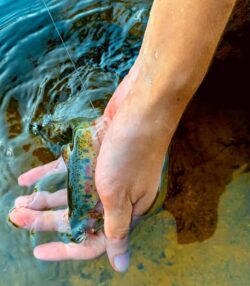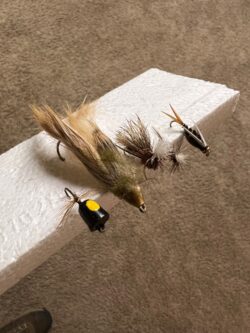Most fly fishermen have loaded fly boxes with many variants of many flies. Every time they go to a new watershed, there is a new secret fly. Flies come in all sizes and colors. They can be crippled, emerged, drowned, larval, pupa, scuddy, and streamlined. Flies can be old or new.
What if you could only have 1 fly for each main fly-fishing variation. This means just one Dry, nymph, streamer, and terrestrial. Your expenses and number of fly boxes would certainly decline. You could have each fly in a variety of sizes, but the pattern would need to be the same. 
Years ago, I went with only one pattern fly. The Royal Coachman was a colorful pattern that could be made into every pattern and style. My dry fly was a Wulff version in traditional colors and also in chartreuse. My PMX version could be fished dry or as a rubber legged nymph. The PMX was an awesome hopper match. A Spruce fly variation worked well as my streamer. Everything fit into just 2 boxes!
I used these flies for an entire season as a guide and for my own use. What I discovered was that the fly was not the most important thing. Unsuccessful fishermen focus on the wrong things.Their search for the one best fly, spot, or thing is futile.
A fish has to eat. Their tiny brains are not analytical computers. They would strike a cigarette butt if presented properly. There is not just one most important thing to make you a successful fly fishermen and there is not just one fly that is the most indispensable.
Presentation is the most important tip! This means more than just the fly. It also means where you are fishing, when you are fishing, how you approach where you are fishing, What you are wearing, what you are seeing, how you are using the rod, line, and reel, and so many more things. If just one thing is out of whack, everything goes wrong. Once you accept and understand what fly fishing is, you are ready to learn how to fly fish.
Most fly fishermen use what has worked in the past. They may only change things up a few times a trip anyway. Based on a lifetime of fly fishing, here are my suggested ONE FLIES for each category. 
DRY FLY Adams. You can tie this fly in so many variations and sizes. It will mimic most insects on most rivers. You can parachute hackle, compara dun hackle, or use regular hackle. It can be tied with or without wings.
NYMPH Prince. This classic nymph uses peacock herl to mimic many subsurface bugs. A fly just tied out of peacock herl works great. Make this nymph with or without a bead. Add a longer herl tail and it mimics a leech or damselfly.
STREAMER Madonna This is a tough one. A Clouser minnow would be my second choice but a Madonna cone head tied with rabbit strips makes a great minnow or wooly bugger style streamer. Dead drift a brown Madonna and it becomes a crayfish. You can tie in flash and trash to create a ton of variations.
TERRESTRIAL Cork Popper Now I know that you think I am crazy, but this variation is money. I make these at home using a cork bullet shaped popper. They come in many sizes. My main size choice is 8-16. Black is my primary color but I often paint a yellow dot on top to help me to see it better. When we first invented this fly, we named it the “Black Jap”, because it worked well to mimic Japanese beetles. Of course, this name could be insulting so I now call it a popper.
A popper does more than a pop. It hits the water with a smack that attracts fish. Hoppers, beetles, and ants tied in hair or foam have no mass. They float well but do not ring the fish’s dinner bell the same way. The silhouette of the popper looks just like a Caddis! Mix up the colors and they work in every caddis hatch I have fished. The fly is easy to tie using a popper humped shank hook. Just add a simple hackle at the rear end to mimic legs.
If you are not a fly tier, try a PMX with rubber legs. They come in many sizes and mimic every terrestrial that falls into a river or lake.
If you want to catch 3 times as many fish as you are currently catching, learn how to sharpen your hooks. I give every fly I tie on a few sharpening strokes. This also allows you to inspect the hook, barb, bend, knot, and point.
No matter what fly you select, make sure that your presentation is perfect!
Montana Grant